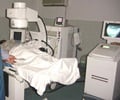Angioplasty-the most common procedure for clearing blocked kidney arteries can also release thousands of tiny particles into the bloodstream that can impair kidney function.
Researchers from Wake Forest University Baptist Medical Center and colleagues has found that angioplasty-the most common procedure for clearing blocked kidney arteries can also release thousands of tiny particles into the bloodstream that can impair kidney function.
“This is the first data in humans to show that debris released during angioplasty and stenting of the kidney arteries can be harmful to kidney function,” said Matthew Edwards, M.D., M.S., lead researcher and an assistant professor of surgery. “It raises important questions about how to most safely perform this very common procedure.”Edwards said that understanding more about potential complications from the procedure can lead to improved treatments. The study, reported in the current issue of the Journal for Vascular Surgery, suggests that having patients stop aspirin use before the procedure may lead to worse results.
It also shows that stent size is important and raises questions about whether blocking or filtering out the debris, known as emboli, may be effective in improving results.
“New devices exist that may prevent the passage of this debris into the kidney and may lead to better patient outcomes,” said Edwards. “We are currently conducting a clinical trial to explore this question.”
As many as 3.5 million Americans over age 65 years have blocked kidney arteries that can lead to severe high blood pressure and kidney failure. These patients have a greater risk of having heart attacks or strokes, becoming dependent on dialysis, or dying.
In some cases, blockages are cleared by inflating a balloon-like device inside the vessel (angioplasty) and inserting a stent to keep the vessel open. The procedure is performed on about 40,000 to 80,000 people a year. Bypass surgery on the arteries is also an option, but few centers offer the complex surgery.
Advertisement
In 28 angioplasty cases, researchers used a protection device to temporarily block the vessel at the site of the angioplasty and stenting. After the procedure, and while the protection system was still in place, researchers took a small sample of blood trapped by the protection device. The artery was then aspirated and flushed out to remove any remaining particles.
Advertisement
“The more particles collected from a patient, the worse their kidney function,” said Edwards. “Patients with higher levels of particles in their blood were more likely to have decreased kidney function after the procedure. Poor kidney function after kidney artery stenting has been previously demonstrated by our group to be associated with increased risk of heart attack, stroke or death in the future.”
The results raise an important question: since the protection device was in place for the procedures, and it is designed to remove particles from the vessel, why did patients who had high particle counts before the artery was flushed also have worse kidney function afterwards"
The researchers theorize that some blockages are more prone to releasing particles than others and that just putting the protection device in place releases particles that reach the kidneys.
“The study raises many questions, including how well the protection device works and can we predict which plaques are more prone to release debris,” said Edwards. “We are currently conducting a clinical trial to try and answer these questions.”
The new study, funded by the National Institutes of Health, will compare results in procedures performed with and without a protection device. The goal of the research is to determine the best way to conduct angioplasty so that results are comparable to or better than surgery. The current research was supported by the National Institutes of Health.
Source-Eurekalert
JAY/C










